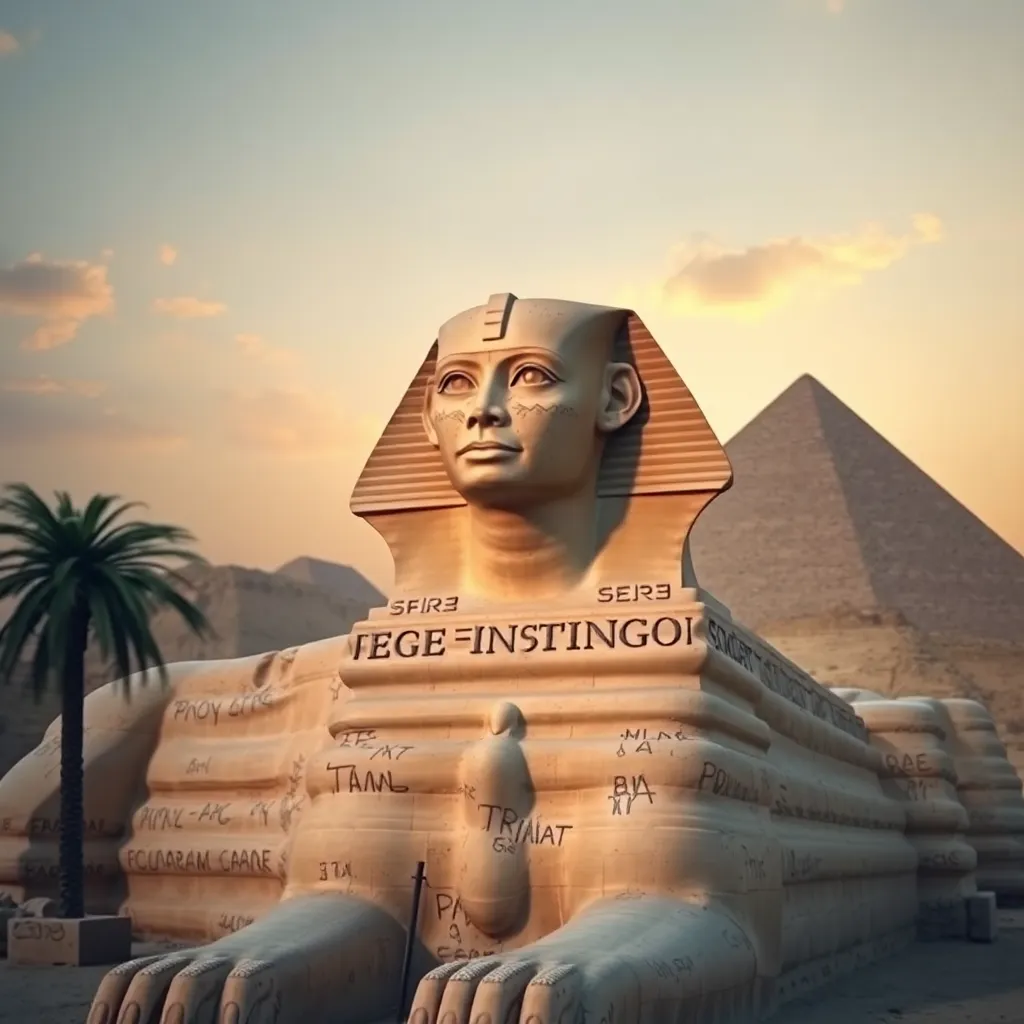The Sphinx: Mythical Creature or Historical Reality?
I. Introduction
The Sphinx, a captivating figure that has stood the test of time, is one of the most recognized symbols of ancient Egypt. With its majestic lion’s body and a human head, it has intrigued historians, archaeologists, and enthusiasts alike. In popular culture, the Sphinx is often shrouded in mystery, representing riddles and enigma, which adds to its allure. This article aims to delve into the historical and mythical aspects of the Sphinx, exploring its origins, significance, and the various interpretations that have emerged over centuries.
II. Historical Background of the Sphinx
The origins of the Sphinx can be traced back to the Old Kingdom of Ancient Egypt, specifically during the reign of Pharaoh Khafre (c. 2520–2494 BC). The Great Sphinx of Giza, located on the Giza Plateau, is the largest monolithic statue in the world, measuring approximately 20 meters (66 feet) high and 73 meters (240 feet) long. This monumental structure is carved from limestone and represents not only an architectural marvel but also an archaeological treasure.
The Sphinx holds significant historical importance, as it provides insight into the religious and cultural practices of ancient Egyptians. It is believed that the Sphinx served as a guardian, protecting the nearby pyramids and the tombs of the pharaohs. Historical accounts from ancient texts, including writings from Herodotus and later scholars, mention the Sphinx, albeit with varying interpretations and legends.
III. The Mythology of the Sphinx
In Egyptian mythology, the Sphinx is often associated with the sun god Ra and represents strength, wisdom, and protection. Its role as a guardian creature aligns with the belief that it safeguarded the entrances to sacred spaces, especially tombs.
Interestingly, the Sphinx has a counterpart in Greek mythology, where it is portrayed as a creature with the body of a lion, the wings of a bird, and the head of a woman. The Greek Sphinx is infamous for posing riddles to travelers, devouring those who failed to answer correctly. This stark contrast highlights the differing symbolism between the two cultures:
- Egyptian Sphinx: A protector and guardian.
- Greek Sphinx: A treacherous being associated with riddles and death.
The Sphinx also appears in various other cultures, symbolizing power and wisdom, and reflecting the universal human fascination with such mythical beings.
IV. Symbolism and Interpretation
The Sphinx embodies several layers of symbolism, primarily representing power, protection, and the divine nature of the pharaohs. Its lion’s body symbolizes strength and courage, while the human head signifies intelligence and wisdom. Together, they create a hybrid figure that epitomizes the ideal ruler in ancient Egyptian society.
Many interpretations have emerged regarding the features of the Sphinx:
- The lion’s body represents the might of the pharaoh and the animal kingdom.
- The human head signifies the pharaoh’s intellect and divine rule.
- Its position facing east is believed to be a connection to the rising sun, reinforcing its divine association.
V. Theories on the Purpose of the Sphinx
Scholars have proposed various theories regarding the Sphinx’s purpose and significance in ancient Egyptian society. Some of the prevailing theories include:
- The Sphinx as a guardian of the Giza Plateau and the pyramids, serving to protect the tombs of the pharaohs.
- Its alignment with celestial bodies, particularly the sun, suggesting it had astronomical significance.
- The role of the Sphinx in funerary practices, possibly linked to the rituals associated with the afterlife.
The debate surrounding these theories continues, with researchers examining the Sphinx’s alignment with various landmarks and celestial events to uncover deeper meanings behind its construction.
VI. Archaeological Discoveries
Key archaeological findings related to the Sphinx have shed light on its historical context. Excavations around the Giza Plateau have revealed various artifacts and structures that suggest the Sphinx was part of a larger complex involving temples and other monuments.
Techniques used in the study and preservation of the Sphinx include:
- Geological surveys to assess the limestone structure.
- 3D scanning and imaging to document its features and condition.
- Restoration efforts to preserve the integrity of the statue against erosion and environmental factors.
Recent discoveries, such as the uncovering of tunnels and chambers beneath the Sphinx, have challenged existing narratives and opened new avenues for research and exploration.
VII. The Sphinx in Modern Culture
The influence of the Sphinx extends beyond ancient history; it has permeated modern art, literature, and popular media. Artists and writers have often drawn inspiration from its enigmatic presence, incorporating it into various works:
- In literature, the Sphinx is frequently referenced as a symbol of mystery and the unknown.
- In art, it is depicted in various forms, ranging from classical sculptures to contemporary interpretations.
- In films and games, the Sphinx often serves as a plot device, representing riddles or ancient secrets.
The impact of tourism on the perception of the Sphinx cannot be overlooked. Millions of visitors flock to see this monumental statue each year, contributing to the local economy but also raising concerns about preservation and the effects of human interaction on such an ancient structure.
VIII. Conclusion
The Sphinx stands as a remarkable testament to both the mythical and historical dimensions of ancient civilizations. It embodies the dual nature of being a mythical creature and a historical reality, representing the ingenuity and beliefs of the ancient Egyptians. As ongoing research continues to uncover more about the Sphinx, its significance in understanding ancient cultures remains profound.
Encouraging further exploration and preservation of such historical sites is crucial, as the Sphinx not only offers insight into the past but also connects us to the enduring legacy of humanity’s quest for knowledge and understanding.




